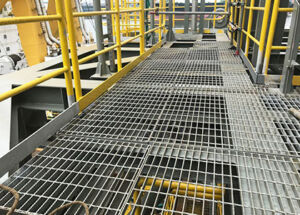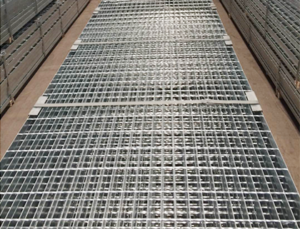Welded steel grating and press locked grating are two common types of steel grating used in various industrial and commercial applications. Both types of grating have their own unique characteristics and advantages, making them suitable for different environments and requirements. In this article, we will compare welded steel grating vs press locked grating in terms of their construction, strength, durability, and applications.
Welded steel grating is manufactured by resistance welding the bearing bars and crossbars at their intersections. This process produces a strong and durable grating with high load-bearing capacity. Press locked grating, on the other hand, is constructed by interlocking the bearing bars and crossbars together under high pressure, creating a flush top surface. This method results in a lightweight and versatile grating with a smooth and aesthetic appearance.

One of the key differences between welded steel grating and press locked grating is their construction method. Welded steel grating is produced by welding the bearing bars and crossbars together, creating a rigid and stable structure. Press locked grating, on the other hand, is manufactured by mechanically pressing the crossbars into the bearing bars, providing a secure and flush fit. This difference in construction affects the overall strength and load-bearing capacity of the grating, making them suitable for different applications and environments.
In terms of strength and durability, welded steel grating is known for its high load-bearing capacity and resistance to impact and heavy loads. The welding process creates a strong bond between the bearing bars and crossbars, resulting in a rigid and stable grating that can withstand heavy foot traffic and dynamic loads. Press locked grating, while not as strong as welded steel grating, offers good strength and durability for applications that do not require heavy load-bearing capacity. Its interlocking construction provides a secure and stable grating that is suitable for pedestrian walkways, scândură scării, and light-duty industrial applications.
Another important factor to consider when comparing welded steel grating vs press locked grating is their applications. Welded steel grating is commonly used in industrial and commercial settings where heavy loads, vehicular traffic, and dynamic loads are present. Its high load-bearing capacity and durability make it ideal for platforms, catwalks, ramps, and industrial flooring. Press locked grating, on the other hand, is often used in architectural and decorative applications where aesthetics and design are important. Its smooth and flush top surface provides a clean and modern look, making it suitable for pedestrian walkways, sunshades, and architectural facades.

In summary, both welded steel grating and press locked grating have their own unique characteristics and advantages. Welded steel grating is known for its high strength, durability, and load-bearing capacity, making it suitable for heavy-duty industrial applications. Press locked grating, on the other hand, offers good strength and versatility with a focus on aesthetics, making it ideal for architectural and decorative applications. When choosing between welded steel grating vs press locked grating, it is important to consider the specific requirements and environmental conditions of the project to determine the most suitable type of grating.

